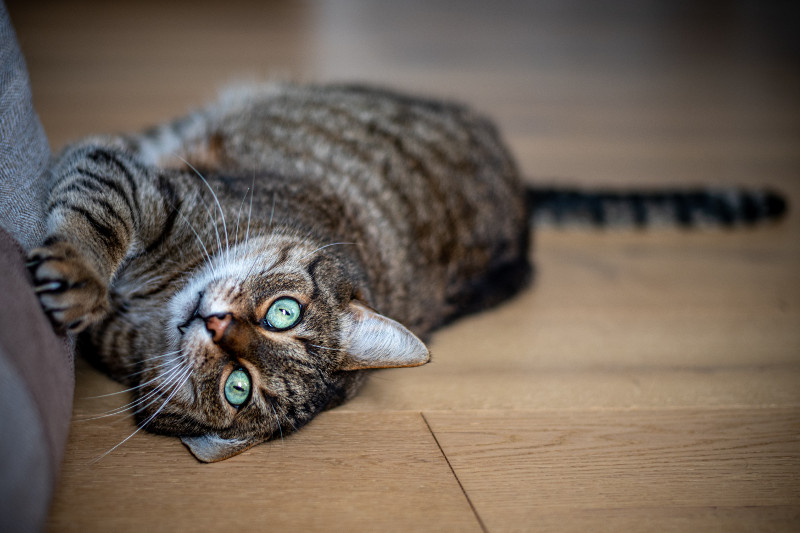Cats are naturally intuitive predators possessing sharp retractable nails. While cats often use their claws for hunting and capturing prey, they also serve a number of other purposes that make scratching a normal and necessary behaviour. In fact, many cats need to scratch regularly to benefit their physical and mental health.
Did you know? Scratching is often an outlet for cats to express their emotions. Every cat has their own unique individual personality, and scratching allows them to process those emotions in a healthy way. These expressions can be reflective of heightened levels of stress or anxiety, frustration, over-excitement, pent-up energy, and more.
Another common reason for cat-scratching behaviour is to mark their territory. Cats have scent glands located in their paws, and when they scratch this scent is released. It is believed that this behaviour helps tell other animals that your cat has claimed this space. This is a very common behaviour in multi-cat households, especially if there is more than one dominant-minded feline in the same space.
Practical reasons for scratching also exist. For example, scratching allows your cat to shed dead parts of their nails. And, of course, scratching is a great way to have a relaxing pleasurable stretch for the nails, paws, and the rest of the body.
Scratching furniture is one of the most common behavioural problems reported among cat owners. Contrary to popular belief, cats don’t target furniture to be purposely vindictive, however this type of scratching can quickly result in the destruction of furniture and other valuable household items. Furthermore, the more normalized scratching furniture becomes, the more difficult it is to curb this unwanted behaviour.
Thankfully, there are steps you can take to help reduce or eliminate unwanted scratching, no matter how many cats you have.
Keep Nails Trimmed Regularly
Cat nails should be trimmed about once a month, however that varies from cat to cat. Routinely cutting your cat’s nails is an excellent way to reduce damaging scratching behaviours. When a cat’s nails reach a point of overgrowth, the irritation encourages your cat to scratch more.
Signs of overgrown cat nails include:
- Biting and pulling at their nails
- Excessive scratching
- Nails getting stuck in things like blankets, drapes, etc.
- Sharp nail tips sticking out even when the nails are retracted.
There is an inherent safety risk when trimming cat nails, which is one of the primary reasons many pet groomers do not groom cats. While certain cats have a calm enough disposition to make nail trimming a breeze, this is not the reality for most. Many sass-filled kitties will relentlessly fuss, hiss, scratch, and even bite their way out of a nail trim session. Cats are extremely flexible and wildly unpredictable, giving them the capacity to make nail trimming an utterly impossible chore.
For those who are nervous or unsure about cutting their cat’s nails, certain pet groomers offer inexpensive cat-specific nail trimming services.
Give Them Something To Scratch
Commercial scratching posts, typically made of sisal rope or corrugated cardboard, are designed to be a durable and desirable scratching surface. Cats typically prefer their scratching post to be tall enough to get in a good long stretch, and also sturdy enough that they feel safe scratching them. Wall mounted scratch posts, and scratch posts with a solid, wide base are great options for this reason.
Training Is Key
Believe it or not, you can usually (hopefully) train unwanted behaviours out of cats! If they like to scratch a certain area, such as the corner of the couch, place a scratching post right beside it. This will help encourage your cat to choose the more cat-friendly option.
To protect household items your kitty has been scratching, there are many things you can do to encourage her to scratch elsewhere. One option is to temporarily use a deterrent training spray. Once you spray the area you want to protect from scratching, the bitter smell from the spray will discourage your cat from doing further damage.
Additionally, cover the area with tin foil, clear double-sided tape, a garbage bag, or a tight fitted sheet. By making the area less desirable, your cat will likely move on from couch-scratching, however there must be suitable scratching options readily available.
Should I Declaw My Cat?
In short, no. There is never a justifiable reason to declaw a cat, and this barbaric practice is prohibited in many parts of the world. Declawing can cause a variety of issues like lifelong pain and permanent negative behavioural changes.
By properly maintaining your cat’s nails, and providing plenty of cat-appropriate scratching surfaces, you can be well on your way to protecting your furniture, while also keeping your cat happy.
Brandon Forder, known as The Pet Expert, is vice-president of Canadian Pet Connection, an industry leader in healthy pet lifestyles. Brandon is certified in pet nutrition, and has more than twenty-five years’ experience specializing in pet health and behaviour. He has written hundreds of informative pet-related articles for newspapers, magazines, radio, and the popular Ask the Pet Expert Blog. Brandon is highly skilled in pet problem solving, and enjoys teaching others about smart and responsible pet ownership. To learn more, visit www.CanadianPetConnection.ca.












